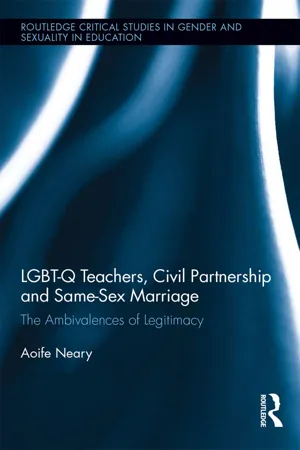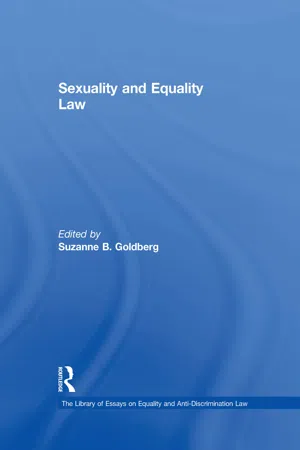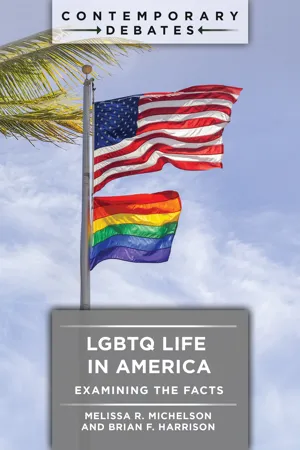History
LGBTQ Rights UK
LGBTQ rights in the UK have evolved significantly over time. Key milestones include the decriminalization of homosexuality in 1967, the equalization of the age of consent in 2001, and the legalization of same-sex marriage in 2014. The UK has also implemented anti-discrimination laws to protect LGBTQ individuals in various aspects of life.
Written by Perlego with AI-assistance
Related key terms
Related key terms
1 of 4
Related key terms
1 of 3
6 Key excerpts on "LGBTQ Rights UK"
- eBook - ePub
LGBT-Q Teachers, Civil Partnership and Same-Sex Marriage
The Ambivalences of Legitimacy
- Aoife Neary(Author)
- 2016(Publication Date)
- Routledge(Publisher)
In Ireland in the 1990s, LGBT-Q politics became mobilised around the acquisition of rights as a key strategy in marking Ireland as a ‘modern’ nation. Echoing LGBT-Q political narratives in the new democratic era in Argentina (Encarnacion 2011), Rose (1994, p. 3) asserts that the changes that resulted in the decriminalisation of homosexuality in Ireland ‘stem from positive and traditional Irish values arising from the anti-colonial struggle’ with Britain. In contrast to Rose’s (1994) claims, Conrad (2001; 2004) notes how uneasily the concept of homosexuality sits alongside the concept of Irish national identity: first, because its existence destabilises a unified identity, and second, because it threatens the heterosexual, reproductive, ‘natural’ family cell that is at the basis of discourses of nationalism. The notion of the heteronormative Irish ‘family cell’ has been used as a political trope in Ireland and transnationally (Gray 2004). It has played a part in the regulation and reproduction of normative sexuality and its use in discourse of national identity has oftentimes reinforced the notion that ‘homosexuality is never “native”; and that the heterosexual family cell, and by extension the nation, are susceptible to “infection”’ (Conrad 2004, p. 25). Assumptions about an Irish ‘tradition of tolerance’ and ‘inclusion’ and a progressive future based on a fictive Irish national identity reify binaries of ‘them’ and ‘us’, ‘past’ and ‘present’ in problematic ways. In this light, the aforementioned fervent opposition in Ireland to the Ancient Order of Hibernians in New York (organisers of the St. Patrick’s Day parade that for twenty-six years banned LGBT-Q people from marching) might also be read as a distinct attempt to mark the diaspora as traditional and backward in contrast with a new ‘modern’ vision of Irish national identity ‘at home’. The perspectives presented here underscore how sexual citizenship is thoroughly intertwined with narratives of national identity. ‘Modern’ is most often equated with Euro-North American under the banner of ‘universal’ human rights, with normative, normalising and exclusionary effects.The final section of this chapter turns to another topic that is bound up in LGBT-Q activism and sexual citizenship debates worldwide—religious freedom. In what follows, the tensions between LGBT-Q and religious rights are discussed as legal structures for same-sex relationship were introduced across a variety of contexts.Polarisation of LGBT-Q and Religious Rights
Much religious doctrine, teaching and practices continue to declare the illegitimacy of LGBT-Q identification and same-sex relationships. ‘Queer’ is conflated with secularism, and religion with conservatism and repression. Such essentialised perspectives render LGBT-Q people who have religious affiliations as unintelligible, uneducated or unstable (Gold 2010; Shannahan 2010). Recent work has interrogated these conflations (Hunt 2009; Browne et al. 2010; Yip. 2010; Taylor et al. 2014; Taylor and Snowdon 2014a; 2014b) and this is discussed in more detail in relation to LGBT-Q teachers’ attachments to religiosity and claims to cultural legitimacy in chapter seven . In many countries, the emergence of same-sex partnership legislation has been fraught with tensions between LGBT-Q and religious rights. Fundamentalist religious organisations and devoted followers of organised religions generally comprise the strongest opposition to LGBT-Q rights (Ogland and Verona 2014; Neary 2016). However, as discussed in relation to national identity, examinations of local contexts of religious beliefs and attitudes help provide a more nuanced story (Munt and Jenzen 2012). For example, Adamcztk and Pitt (2009) found that personal religious belief has a particularly significant effect on attitudes towards LGBT-Q identification in the U.S. because of high levels of self-expression and the expectation to have a diversity of perspectives in the public sphere. Using Ireland as an illustrative case, this section outlines how LGBT-Q/religious and secular/religious polarisation occurred in debates about legal structures for same-sex relationships. In so doing, this section explores the more nuanced cultural workings of religiosity—a theme that is discussed in much more detail in chapter seven - Charlotte Knight, Kath Wilson(Authors)
- 2016(Publication Date)
- Palgrave Macmillan(Publisher)
1998 ).The Equality and Human Rights Commission was launched in 2007 and replaced organisations such as the commission for Racial Equality and the Equal Opportunities Commission. Its task is to promote fairness and promote equality across seven strands, one of which is sexuality (Government Equalities Office, 2013 ). The twenty-first century has seen real changes in legislation that redress most of the inequalities faced by the LGBT community, and in the next section some of the key legislative areas of change since the passing of the Human Rights Act (1998) have been set out. One significant change is the wide range of support these changes have enjoyed across political parties and organisations.Recent Key Legislation
The following list of legislation applies to LGBT people in a range of ways. Legal protection against discrimination has come slowly, but in recent years it has gathered pace and breadth with a substantial number of acts or regulations being passed:- Data Protection Act 1998;
- Gender Reassignment Regulations 1999;
- Sex Discrimination (Northern Ireland) Order 1976 (1999);
- The Sex Discrimination (Gender Reassignment) Regulations (N. Ireland) 1999;
- The Employment Equality (Sexual Orientation) Regulations 2003;
- The Domestic Violence, Crime and Victims Act 2004;
- Gender Recognition Act 2004;
- Gender Recognition (Exceptions to Offence of Disclosure) Order 2005;
- The Civil Partnership Act 2005;
- The Equality Act 2006 (Access to Goods, Services and Facilities);
- eBook - ePub
The Lesbian and Gay Movement and the State
Comparative Insights into a Transformed Relationship
- David Paternotte, Manon Tremblay(Authors)
- 2016(Publication Date)
- Routledge(Publisher)
12 United Kingdom_ Changing Political Opportunity Structures, Policy Success and Continuing Challenges for Lesbian, Gay and Bisexual Movements Kelly Kollman & Matthew Waites DOI: 10.4324/9781315556178-13Introduction
The United Kingdom (UK)1 entered the second decade of the twenty-first century with an extensive set of legal mechanisms to promote the formal equality of lesbians, gay men and bisexuals (LGB). Social movement organizations have played a crucial role in fostering a rather dramatic expansion of LGB rights in the UK since 1997. These legal reforms include the equalization of the age consent, the creation of civil partnerships, the legalization of adoption for same-sex couples, and the creation of a public sector ‘equality duty’ by the Equality Act in 2010.2 But despite these recent policy successes the country often has lagged behind its West European neighbours both in terms of implementing legal protections and developing grassroots movement organizations.1 The UK is made up of four different regions: England, Northern Ireland, Scotland and Wales. This chapter largely focuses on developments at the national level in the UK, i.e. organizations’ influence on the national parliament in Westminster. Since devolution in 2000 the Scottish parliament has gained considerable power to implement and enforce human rights and family policy; the Welsh and Northern Ireland assemblies are much weaker. Where space allows we try to mention separate developments that have taken place in Scotland, Northern Ireland and Wales.2 The Labour government also increased the legal recognition of transgender people, see especially the Gender Recognition Act 2004 - eBook - ePub
- Suzanne B. Goldberg(Author)
- 2017(Publication Date)
- Routledge(Publisher)
Finally, some of the difficulties presented by rights-based strategies will be discussed. The chapter will conclude by suggesting that while ‘lesbian and gay rights’ has value as a campaigning slogan, complacency about its meaning and scope – assuming, for example, that there is only one possible view of what can count as a ‘lesbian and gay rights’ issue, or that the ambit of the slogan is sufficiently self-evident that deeper exploration is unnecessary – is likely to distort political debate and conceal some difficult issues which must be addressed if lesbian and gay law reform is to be tackled coherently. 9 It is as a sign of the uncertain ambit and meaning of ‘lesbian and gay rights’ – and not because of disrespect for the moral claims which may underpin the phrase – that inverted commas have been placed around it in the discussion which follows. 10 Rights as entitlements In 1970, the Male Representatives of National Gay Liberation made the following claim in the United States: We Demand:. .. The right to be gay anytime, anyplace.. . The right of free dress and movement. . . That all modes of human sexual self-expression deserve protection of the law, and social sanction... That gays be represented in all governmental and community institutions... That gays determine the destiny of their own community. .. Finally, the end of domination of one person by another. 11 In similar vein, the London arm of the Gay Liberation Front argued, in the winter of 1970/71, that: ‘We believe. .. every person has the right to develop and extend their character and explore their sexuality through relationships with any other human being, without moral, social or political pressure.’ In consequence, the Front called for: The same right to public expressions of love and affection as society grants to expressions of hate and scorn - eBook - ePub
LGBTQ Life in America
Examining the Facts
- Melissa R. Michelson, Brian F. Harrison(Authors)
- 2021(Publication Date)
- ABC-CLIO(Publisher)
2 LGBTQ Political and Legal Treatment Over TimeWhen people think about the beginning of the fight for equal rights for the LGBTQ community, the first thought for many is the riots at the Stonewall Inn in New York City in 1969. While Stonewall was a pivotal and important part of LGBTQ history, Q8 notes that it did not mark the very beginning of the contemporary LGBTQ rights movement. There are other important aspects of LGBTQ political and legal treatment over time that have often gone unnoticed and this chapter provides key insights into the evolution of political and social debates regarding LGBTQ issues in our time.Q9 delves into the claim that some of the strongest opponents of LGBTQ rights are, in fact, closeted LGBTQ people themselves. Several questions investigate the notion that equal rights for LGBTQ people will infringe on other important American rights. A perceived tension between religious freedom and LGBTQ rights, one that has lingered for decades, is addressed in Q10. The claim that granting LGBTQ rights will result in other consequences like legalized bestiality and necrophilia is addressed in Q11. Q12 investigates the rate of hate crimes against LGBTQ people over time. Finally, Q13 summarizes the ways that LGBTQ people continue to experience legal discrimination in the United States.Q8: DID THE GAY RIGHTS MOVEMENT BEGIN AT STONEWALL IN 1969?Answer: No. The Stonewall Riots that occurred in New York City in 1969 are considered the symbolic launch of the modern gay rights movement but gay and lesbian organizations in the United States have been fighting for equality since at least 1924. In fact, important events prior to the Stonewall Riots give key context to how and why the riots took place.The Facts: - Deborah Price, Kath Tayler(Authors)
- 2015(Publication Date)
- Routledge(Publisher)
In 2003, the Employment Equality (Sexual Orientation) Act came into force, making it illegal to discriminate against lesbians and gay men in the workplace. This didn't give as much protection to gay people as their heterosexual colleagues, and it wasn't until 2007, with the Equality Act (sexual orientation) Regulations, that parity was achieved.In 2000, the ban on lesbians and gay men serving in the armed forces was lifted. Until then, lesbians and gay men could not be openly gay, and if their sexuality was revealed they could be dismissed with no recourse to compensation.Marriage
In 2004, civil partnerships were introduced in the UK, and this was extended to marriage in 2014. The rights that had been introduced with civil partnerships did not extend, but significantly, calling it ‘marriage’ was a crucial step in equality for gay and lesbian couples. While writing this, there is a new ruling approved where couples with civil partnerships can transfer this to a marriage from December 2014.Other laws have been passed in very recent years that protect the rights of lesbians and gay men in terms of goods and services and incitement to homophobic hatred.Conclusion
We hope that reading this chapter will provide material for reflective discussion in staff meetings and also individual consideration of the issues raised. Here are some interesting points to think about as a result of reading this chapter:- The great disparity that there has been, until very recently, between the rights of the heterosexual community and those of lesbians and gay men. Think about the fact that there are gay men alive who have experienced both the criminalisation of gay relationships and also the legalisation of gay marriage.
- The fact that this disparity of rights still continues in many countries around the world, and that this is not limited to so called ‘Third World’ countries – 13 states in the USA have anti-sodomy laws on their statute books. Some of these countries have also signed up to protect the rights of the child. Is this possible?
Index pages curate the most relevant extracts from our library of academic textbooks. They’ve been created using an in-house natural language model (NLM), each adding context and meaning to key research topics.
Explore more topic indexes
Explore more topic indexes
1 of 6
Explore more topic indexes
1 of 4





